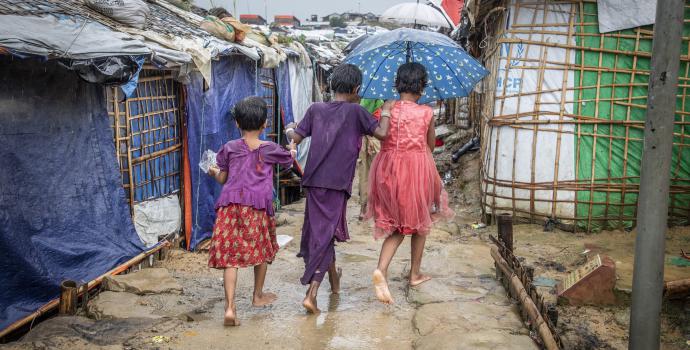Source: Save The Children
Rohingya children and their families have been fleeing Myanmar for generations to escape persecution and violence. As a new Save the Children report reveals, there are more than 700,000 Rohingya boys and girls across Asia today, most of them refugees. But far from finding a safe haven abroad, Rohingya children are still ostracised from their societies. They all struggle to access basic services, live at risk of abuse and exploitation, and live with the trauma of being uprooted from their homes.
Here are five stories from five Rohingya children, each sharing their experiences from a different country in Asia.
Abdul*, 14, lives in Rakhine State, Myanmar along with his mother and two older brothers
I’ve lived here all my life. I’m in Grade 8, and like reading books and seeing my friends at school. But access to high quality education is not available, and some students can’t afford to attend school. Outside of school I like playing badminton and football, riding my bike, and talking with my friends.
Travel and freedom of movement is restricted here. It’s free for people from other ethnic groups but not for us because we are Rohingya. If we travel to faraway places, there is always fear police might arrest us. There is also the danger of landmines. The authorities arrest people if we are found outside [during curfew hours].
I want a future without difficulties and to have a good business so I can earn money and build a house for my family. I want freedom, independence, and rights for Rohingya, including easing of movement restrictions
Rashida*, 9, was just five years old when she fled Myanmar in 2017. Today, she lives in a refugee camp in Cox’s Bazar, Bangladesh
I miss my home in Myanmar. In the camps here it is very hot: there are no trees. Back home in Myanmar we had many trees around to keep us cool and we could play outside, but here we cannot. During the rainy season, water floods our shelters and snakes and insects come inside. I go to school but the schools have been closed here for over a year now [because of the pandemic].
The school could be improved if they teach us using the Myanmar curriculum. If they use this system and have Myanmar teachers, our education will improve. It would help me to be a doctor or teacher.
I am worried that if we cannot access education and study here, our life will be very dark and we will not have a future.
Abdul*, 15, lives in Malaysia where he fled to with his family from Myanmar in 2019. He lacks legal status in Malaysia and the fear of arrest is ever-present
[In Myanmar] my family and I were persecuted from all sides. I wasn’t allowed to work and I was discriminated against. People harassed us, and my mother and my sister were beaten when I was young. Because we are Rohingya, we weren’t allowed to go out in the evening. Sometimes, the police took Rohingya youths to the police station and tortured them.
Once I arrived here, the lockdown started and it became hard to survive. I thought that I could find a job to support to my mother and sisters, but in reality, it is hard to get a job [without papers]
I can’t go out [with my friends] when they call me to play because I don’t have documents here. I’m afraid of police and of being arrested.
Rafique*, 16, made a harrowing overland journey through Thailand when he fled Myanmar
I left Rakhine State in September 2019. I took a boat for three days, and then we had to walk through the jungle for 56 days… After, I stayed [in Yangon] for 13 days, then we were taken overland to Mawlamyine.
The next morning, we arrived in Thailand and began the journey to Malaysia. After one hour, we were arrested by police. We were held in police custody for a day – the agent [human trafficker] helped release us. Then we took a car train, and another car to the Malaysian border. Once in Malaysia, we took a bus to Kuala Lumpur.
The journey was very risky. One of us – I think she was 18 years old – died on the way. While I was in the jungle, I could not get proper food – I could only eat leaves and bamboo shoots. It was so terrible.
I thought I would die.
Amina*, 11, arrived in Aceh, Indonesia in 2020 after spending several months on a dangerous sea journey
I was so tired when I arrived, I could hardly think. We were at sea for months. The boat was so small. There was barely any food and when I wanted to drink there was not enough water. My body itched because I couldn’t take a shower.
I want to go to Malaysia to meet my father. I haven’t seen him since I was born, 11 years ago. I miss him and I only can communicate with him via video calls.
Initially I thought I had arrived in Malaysia… when I found out that I arrived in Aceh it broke my heart because I could not meet him. I want to be with him… I want to have a complete family like everyone else.
Save the Children has released a new report — No Safe Haven: The plight of Rohingya children across Asia — which examines the situation of Rohingya children in five countries in southeast and south Asia: Myanmar, Bangladesh, Malaysia, Thailand, and Indonesia. Rohingya children across these countries are prevented from accessing quality education and legal protection, which can expose them to abuse, child labour, child marriage, trafficking and detention. Save the Children estimates that there are at least 700,000 Rohingya children living in the five countries examined in this report.



